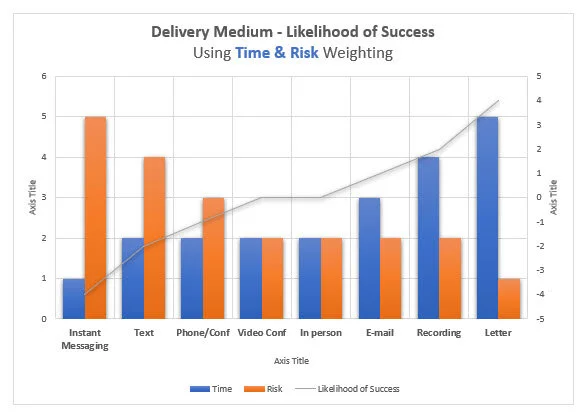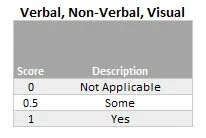Communication Likelihood of Success - Take The Time, Reduce The Risk!
Instant Messaging & Texting
Introduction
Everyone uses various forms of communication on a daily basis and with the COVID-19 impact, we’re relying even more heavily on electronic mediums, but have you ever considered the risk that your message may not be received as you intended? We’ve all heard of a story regarding a co-worker or friend who lost a job or friendship because of an email, text or instant message. lt could innocently happen to anyone and can be prevented!
Early in my career I witnessed a situation that almost cost a colleague their job because they didn’t take the time to review an E-mail message before sending and didn’t consider how the language they had chosen would be received by the person on the other end. Unfortunately, they made a bad choice of words and tossed a pinch of attitude in the mix. It was a wakeup call early in my career; seeing the aftermath made me acutely aware of communication methods and the risk each pose when time isn’t allowed or taken, to review the content before you send the message.
Today, we’re witnessing the expansion and explosion of instant messaging (IM) and texting tools such as WhatsApp, Teams, Skype, other chat tools and it’s worrisome in many respects. These tools, previously and primarily “social”, have moved into the workplace and have taken over as the primary form of communication. They’re displacing written and verbal options; especially as new generations bring their preferences to the office (as E-mail did in the 90’s). While I do believe our ability to communicate in different ways can and has made us more effective, I also believe these tools increase the likelihood that perfect communication will not occur.
Perfect Communication
So what is “Perfect” communication? Some could debate this point, but I’ve always viewed it as simply having a message received exactly as you intended. Improper formation of the message and choice of medium can increase or decrease the risk of an ill received message and taking the time to review your messages before delivering can make or break your likelihood of success.
Likelihood of Success
Before going further, I felt compelled to create a model to provide context (with my own observed and biased ratings of course). Using the mediums listed above, the model considers the time generally required to effectively communicate a message (or the time you take to review the message before sending) and the risk generally associated with that approach (in this case defining “risk” as the likelihood your message will be received as you intended). In the second chart (Figure 4), I added the verbal, non-verbal, and visual components to provide perspective of how they impact the Likelihood of Success. The categories and score I gave to Time and Risk are shown below in Figure 1. The application of these scores are shown in Figure 2:
Figure 1:
Time and Risk rating scores with Description
Figure 2:
Time and Risk impact on Likelihood of Success
I use IM every day of the week to speak with friends, colleagues, customers and business partners around the globe and while I use this method more than any other to communicate, I’m also keenly aware of the pitfalls it can bring.
So, you might wonder, what’s the harm; where’s the risk? The challenge with IM and Text Messaging is the conversational nature and the “back and forth” aspects are similar to in person conversation. The short time duration between messages (and lack of time taken to review), the lack of visuals (body language and images) and verbal context significantly increase the risk that “Perfect Communication” will not occur. If one email can almost destroy someone’s career when given so much time to review before sending, imagine what could happen with chat tools!
In the scoring of IM, I gave it a risk score of 5 (Very High) and a time score of 1 (Very Short). For Text, I chose a slightly lower risk score of 4 (High) and time score of 2 (Short). The following are key reasons these scores were chosen:
IM and Text are very “Conversational” - Because this tool tends to be so conversational with little time taken to review spellings, intent, etc. the risk factor considers the impact of conversational messaging that usually has very little review of content before delivering. Before you know it, a flurry of messages can be sent and by the time you realize something was misread, you may waste significant time trying to correct the misinterpretation or worse yet, repairing a relationship.
Text allows slightly more review time - The delays introduced in texting occur because of how the mobile systems handle text versus IM. IM uses internet data (packet data) to transmit; making the exchange of messages much faster. The additional delay isn’t significant but it is enough to slow down the message exchange; thereby reducing risk and allowing additional time to review messages.
IM, in “pure text” form, lacks the verbal, non-verbal (body language), and visual (pictures) aspects of other communication mediums.
Verbal, Non-Verbal, & Visual Influence on Communication Success
After establishing the initial Time/Risk “Likelihood of Success” line shown in Figure 2, I added Verbal, Non-Verbal, and Visual components using the scoring table in Figure 3 and then calculated a new “Revised Success” line shown in blue (Figure 4). In cases where the use of these components are not guaranteed or are optional but “possible”, a score of .5 (“Some”) was used. IM was given the value of .5 for verbal, non-verbal and visual because each of these could be added to chat messages but are optional. The same scores were applied to text messaging.
Figure 3:
Verbal, Non-Verbal, & Visual Scores with description
Figure 4:
Verbal & Non-Verbal Impacts on Likelihood of Communication Success
Observations
Clearly the addition of Verbal, Non-Verbal and Visual components can influence Likelihood of Success by shifting the line higher. This is especially true for IM and text messaging.
IM can use Verbal (audio), Non-Verbal (emoticons) and Visual (pictures), but are not required and may be rarely used depending on the person compiling the message.
IM can be the worst form of communication with greatest risk of messages being mis-interpreted if time to review the message is not factored into the use of the tool.
In my personal experience, if a conversation turns more serious or emotions escalate, the use of verbal, visual or non-verbal components tend to disappear from the chat message, and this can be the first sign to the recipient that the tone has changed.
Recommendations
Slow it down, Take more time. Re-read what you’re about to send and take the time to consider if additional wordsmithing is required. Even have a friend review the message if you think it might be controversial.
Purposefully introduce delay. If you’re like me and prefer IM over texting, try putting the phone down in between messages to introduce the same time delay a normal text would provide.
Turn off all desktop notifications for IM and text messaging tools (I use google messages to display my mobile text in the browser) so you’re less likely to respond right away. I’ll go back to the messaging window periodically to check for new messages or respond but the purposeful delay helps me control the conversation and ability to review. This is also extremely important for protection of “cross talk” if you’re on a webinar and the message screen pops up. Others may see snippets of conversation not intended for a larger audience and as you can imagine this can present a host of issues.
Follow grammar best practices and take the time to write complete sentences! This is an obvious one but when we let our guard down on IM and text, the sentence structure and translation can be compromised. Sticking to the same best practices you’d follow when writing an email or letter helps ensure the message is received as you intend.
Avoid messaging while driving AT ALL COST! This isn’t an admonishment for driving safer although it’s obviously great advice and illegal in many states. When driving, your guard is down, your focus is elsewhere, and you have practically zero time to proof read your messages. If you absolutely must respond or send a message while driving, use voice to text translation. This will allow you to speak into the phone and have the message translated for you and sometimes spoken language translates better than what you throw together in text.
Start adding Emoticons or any other words that indicate/show your emotional state when sending the message and use in all messaging regardless of the tone/emotion (business or personal). This ensures you’re showing the recipient the emotional state you’re in as you’re making the statements. Body language is a huge deal for me when communicating with others, so I use emoticons liberally to ensure my emotions are clear. Figure 4 illustrates clearly that when the addition of verbal, non-verbal or visual components are added, the likelihood of success line increases and this is true for all forms of communication where possible to include.
If what you need to convey is better heard than read, think of recording a quick audio snippet and attaching it to the IM message. WhatsApp and other tools allow for this. Otherwise, call the person directly.
If you feel yourself getting angry in the course of using IM, step away or put the phone down for a while to ensure you’ve had a chance to take the time to pause and cool down. Remember, time to review the message with IM is the biggest problem because it’s fast and conversational (like two people standing in front of each other) but can become very dangerous when missing other visual cues to the reader, and that leads me to my last point…
Avoid serious conversation in text when possible and this is especially true with IM and text messaging. When you know the emotions are likely to run high, shift the communication method to verbal via phone call, video or in person discussions. I’ve learned this one the hard way. Emotional conversation in text is just simply a bad idea and gives you little control on how you’re perceived.


